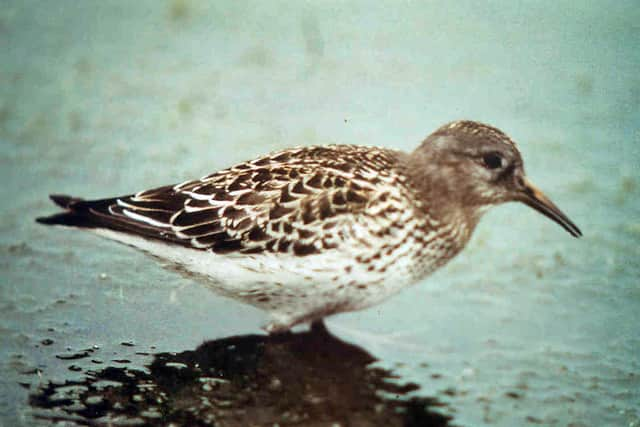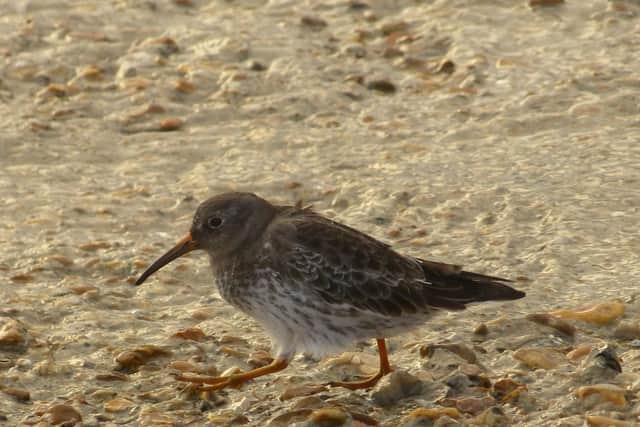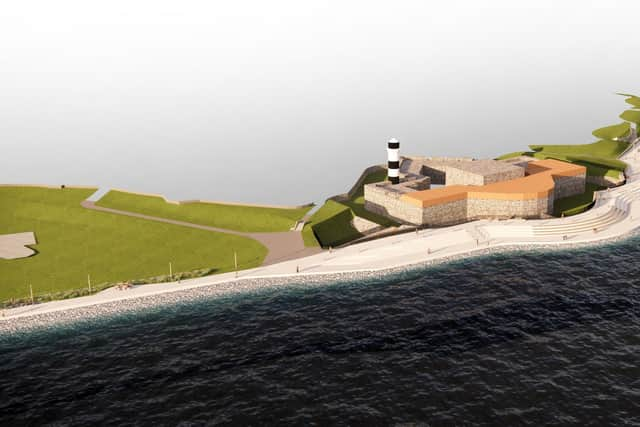Why the habitat of the purple sandpiper bird in Portsmouth should be protected
and live on Freeview channel 276
In a letter to The News he says:
The next phase of work on our city’s coastal defences is due to start in early January. The stretch of coast concerned stretches from the Pyramid Centre past Southsea Castle to children’s corner where the Blue Reef Aquarium is situated. Public notices inform us that the prom in this area will be out of bounds for nigh on two years.
I appreciate the paramount importance of protecting Portsmouth and its inhabitants from a tidal surge. However, this closure causes me concern and regret.


Advertisement
Hide AdAdvertisement
Hide AdThroughout the Covid crisis, I have derived huge comfort and joy from the sea and the coastline. I could wax lyrical on the blessings of nature all around the city and beyond, but the small colony of purple sandpipers who reside on the rocky foreshore beneath Southsea Castle’s walls for six months of the year are a particular favourite. And what is more they are an encouragement and an inspiration.
The purple sandpiper’s Latin name is calidris maritima, most fitting for a bird who has chosen ‘the glagship of maritime England’ (as Portsmouth once called itself) for its home.
The vast majority of these stocky, hardy little waders breed and spend their summers in the Arctic tundra. Some are known to travel to Europe from Arctic Canada. My first sighting of the purple sandpipers’ return in late autumn (this year it was Halloween) is always a day of celebration.


They feed busily along the margin of the tide, nimbly exploring seaweed-covered rocks and leaping out of waves with balletic aplomb. They seek out shellfish, insects, spiders, crustaceans and plants. The artificially constructed rocky breakwater in front of the castle suits them very well.
Advertisement
Hide AdAdvertisement
Hide AdHardly much bigger but rather more portly than starlings (whose own evening murmuration at the pier is a sight to behold), the purple sandpipers are dark grey above and white below. Their legs are bright orange. The ‘purple’ refers to a seldom seen purple sheen on their wing feathers. They are pretty quiet but make small squeaks and chuckle to each other.
During Covid and the lockdowns, the ‘purplies’ have been emblems of endurance and freedom. But these seemingly robust visitors have moved onto the Red List of the UK’s conservation status: a cause for alarm. The Southsea colony is the only one in Hampshire. Accorded Protected Status by the Wildlife and Countryside Act, 1981, this little enclave of birds is all too vulnerable to human depredation and incursion.
Coastal partners, who are carrying out the coastal defence work for the council, admit that their engineering work ‘can impact wildlife and cause unavoidable habitat loss’ and recognise that the purple sandpipers are specifically threatened by the ‘imminent build’. They have pledged to ensure the preservation of their habitat and to protect the fragile population (less than 20 birds this year) by promising enhancements to the scheme.


‘Enhancements such as increasing the area of exposed rocks and creating an artificially textured surface, give the Purple Sandpipers not only more space to feed, but also ensure that the species they feed on have the optimal conditions for colonisation,’ they say, adding: ‘Construction around Southsea Castle will be scheduled to take into account the impact on the overwintering birds. The structure will also be built in stages, ensuring enough time for the species that the birds feed on to colonise and provide enough food for the purple sandpipers over the winter months.’
Portsmouth City Council, for its part, promises:
Advertisement
Hide AdAdvertisement
Hide Ad‘Mitigation measures for our treasures! To minimise disturbance to the birds, we will be putting several mitigation measures in place:
‘A disturbance-free area will be maintained to allow the birds to roost at all states of tide.
‘Noise levels will be monitored to ensure they are not exceeded.
‘New rock installation will take place during the summer season where possible.
Advertisement
Hide AdAdvertisement
Hide Ad‘40 artificial tide pools will be installed in the new rock revetment.’
This is all very encouraging and a source of hope. I applaud the intentions. However, serious concerns remain. Both council and Coastal Partners give inaccurate dates for the purple sandpipers’ overwintering (it lasts a good six months, from late October to early May).
Their focus seems to be on the area directly beneath and immediately adjacent to the castle. The birds actually frequently venture all the way along from the castle to the aquarium and I have seen them shelter from strong winds in the little marine ‘amphitheatre area’ open to the sea just beyond the aquarium.
This whole area is a precious and sensitive ecosystem. Seals and great northern divers have joined the more familiar cormorants and terns fishing in the waters here. The odd sanderling, turnstone and regular oystercatchers keep the purplies company and the rocky coastline is also a crucial habitat for rock pipits who nest within the castle’s bounds.
Advertisement
Hide AdAdvertisement
Hide AdAll of this is under threat, and while purple sandpipers are rather tame, bold and tolerant of humans as birds go, the prospect of them remaining in situ while heavy plant trundles in and goes about its business is far from sure – even less so if some of their domain is encroached upon before May and work is still going on in their territory come October.
Finally, coastal partners’ pledges to protect the fragile population, run counter to the projected images of the pedestrianised walkway right next to the water’s edge in front of the castle. Such proximity and the constant to-ing and fro-ing of human traffic on a level plane, seemingly right next to where the newly deposited rocks would be, does not suggest any such optimal conditions. For all the purplies’ boldness, they have been able to secure this current precious foothold precisely because they are at a critical remove from constant human presence due to a slope (often slippery) of several metres which has allowed this. The sandpipers roost and rest in nooks and hollows in this slope and it is remarkable how well camouflaged they are.
I fervently hope that the welfare of these remarkable birds will be honoured – or that work is delayed for further consideration. I would also like guarantees that experts from such groups as the RSPB, WWT, BTO and HWT are able to have observer status at the site to ensure best practice.
This threat to the purple sandpipers and their ecosystem should also increase our vigilance and resolve against the threats of the proposed disastrous Aquind pipeline and the proposed disastrous despoliation of Tipner West with the ‘super-peninsula plan’.
Advertisement
Hide AdAdvertisement
Hide AdSo much has already been lost due to human arrogance and prodigality. Now more than ever, we must strive to live in harmony with nature.
Portsmouth City Council has been contacted by The News for comment.
A message from the Editor, Mark Waldron
Subscribe here for unlimited access to all our coverage, including Pompey, for just 26p a day.
Comment Guidelines
National World encourages reader discussion on our stories. User feedback, insights and back-and-forth exchanges add a rich layer of context to reporting. Please review our Community Guidelines before commenting.
